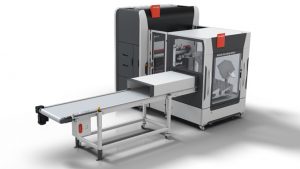 Meeting the demands of your customers’ production orders without having to worry about operator shortages is where automated bending technologies and modern programming systems can really make a difference in achieving greater machine flexibility, availability, and productivity.
Meeting the demands of your customers’ production orders without having to worry about operator shortages is where automated bending technologies and modern programming systems can really make a difference in achieving greater machine flexibility, availability, and productivity.
Operator shortages
So what does a fabricator do when they can’t find press brake operators to run their equipment, or for that matter, find enough of them to run multiple shifts? Purchasing additional press brakes to meet production demands does not make sense if you can’t find operators to run them. Modern offline programming systems combined with press brake automation technologies will help to reduce the number of skilled operators required and enable operators to manage multiple bending cells.
Offline programming
Press brake technologies that specifically focus on easier set-up and programming have enabled press brake automation to be more commonly used to manage day-to-day production demands. Offline programming and simulation are now commonplace. Gone are the days of pendant teaching a robot at the machine for each job. Modern offline programming has evolved to the point where the entire robot program can be generated automatically and checked for collisions before it even reaches the production floor. This greatly reduces press brake and robot setup times and lowers the piece quantity threshold for utilizing bending automation.
When working with earlier offline robot programming systems, what used to take 30 minutes to accomplish now takes only a minute with modern offline programming systems. The time to create a robot bending program is now almost synonymous with the time it takes to create flat part nests. Once the program is created and saved, it can be called up at any time; during an operator’s absence, during off-shifts, or on weekends.
Automating operations
What about operations? Well, that’s where the benefits of press brake automation are really evident. If bending robots are utilized to handle the repetitive tasks of bending, and the bending know-how now resides within the press brake controls and the offline programming system, then you have solved a great deal of your skilled labor shortage problems. With automated bending cells you have now created a consistent method of meeting bending demands regardless of operator labor issues. A single operator can manage multiple bending cells in maintaining material flows, quality control, and tooling setups.
Off-shift operations
One of the key opportunities derived from press brake automation is the ability of the systems to operate in the off-shifts to increase throughput. Utilizing automation provides the flexibility to operate a press brake in the off-shifts and on weekends to fully utilize the additional bending capacity created with press brake automation and providing the ultimate flexibility with bending operations.
Changing the status quo
For overall productivity and flexibility, adding robot press brake automation and offline programming greatly changes the status quo. There is no longer the need to have an operator for each press brake machine, but rather one operator for multiple cells. The machines will no longer sit idle during meal brakes, lavatory breaks, and shift changes. You no longer need to be concerned about operators calling in sick for prolonged periods. Furthermore, operator fatigue will no longer be a variable with regard to how productive or efficient they are on any given day, providing consistency in production planning and meeting customer delivery deadlines.
Achieving more with less
Utilizing modern offline programming technologies with automated bending technologies, working in unison, will achieve more with less; more productivity with less labor, greater part quality with less skill set, higher productivity and revenue with fewer machines.
By Frank Arteaga, Regional Director of Marketing, Bystronic Inc., Hoffman Estates, IL
Voice.bystronic@bystronic.com
